A craze for tight-lacing emerged again in the late '60s when the skirt was gored and slim fitting at the waist and across the stomach. The development of the bustle by 1870 temporarily offset this. However, in the mid 1870s, dress bodices further tightened and lengthened. Corsets had to follow suit. This was only possible due to new developments in corset manufacture. A greater number of shaped pieces, many more bones, starch and steam moulding gave a well-sculpted, armour-like garment. Spoon busks were also used during the '70s and '80s - curved front clasps that widened over the stomach.
These late Victorian corsets were more than just utilitarian. The best examples were made in costly silks in a variety of colours and decorated with embroidery, lace and ribbon.

By 1900, suspenders had become attached to the bottom of corsets. The curved front of the corset straightened, no longer dipping in at the waist. This was considered to be a more healthy cut.
During the nineteenth century, the corset tended to be worn under the petticoat, until the cuirasse dress of the 1870s induced the fashionable woman to wear her under-petticoat beneath her corset. The corset shaped the Victorian woman. It tended to elevate the bust (a leftover of the Regency period) flatten the stomach, narrow the waist and generally smooth out the irregularities in her figure. The result was very curvaceous and womanly, though very restrictive. The culmination of this hourglass look came in the 1870s with the cuirasse bodice, when even the outward curve of the hips was revealed by the clinging cut of the dress. During the later bustle years of the 1880s, the figure remained sleek under all of the drapery.
Bustle
During the 1880s, pannier-like skirt drapery reappeared, and the bustle soon followed. This time the silhouette was less domed and more angular, the skirt jutting out horizontally and then sharply dropping down like a table. The 1880s bustle can be achieved with two or three steels threaded horizontally through the back panel of a dress underskirt or separate petticoat and tied across the inside, with the addition of a small pad to prevent the top from sagging. However, a good variety of patent bustles were available in the 1880s to be worn under the petticoat.
Bust Improvers
Bust-improvers enhanced the bust when fashion demanded it. They ranged from light padding on the inside of 1840s bodices, (filling in the hollow below and the ridge above the elevated bust-line), to the wire domes of the curvaceous 1880s, (which look suspiciously like two small sieves on a piece of string). It is difficult to give these garments the serious attention they deserve.
Early Victorian underwear was very plain and utilitarian and often made of firm, white linen, though cotton was emerging as an alternative. Everything was handsewn, and trimming was kept to a minimum. As the century progressed, cotton began to replace linen as the affordable fabric of everyday underwear.
In the 1870s and 80s a craze for woollen underwear arose - wool next to the skin was the newest health fad. Fitted combinations of knitted woollen fabric were promoted by Jaeger - a high street label that is still around today. Cellular cotton (Aertex) underclothing also enjoyed limited popularity. These kinds of fads erred on the sensible side and though popular, were not considered highly fashionable.  One fabric that emerged in the 1880s, however, was extremely fashionable. Silk underwear, along with the finest cottons and linens, was luxurious and highly favoured. White was still the predominant colour of most underlinens, but cream silk was available as was black by the 1890s. Flannel underclothing, however, was often coloured, as were many decorative petticoats by the 1860s.
One fabric that emerged in the 1880s, however, was extremely fashionable. Silk underwear, along with the finest cottons and linens, was luxurious and highly favoured. White was still the predominant colour of most underlinens, but cream silk was available as was black by the 1890s. Flannel underclothing, however, was often coloured, as were many decorative petticoats by the 1860s.
 One fabric that emerged in the 1880s, however, was extremely fashionable. Silk underwear, along with the finest cottons and linens, was luxurious and highly favoured. White was still the predominant colour of most underlinens, but cream silk was available as was black by the 1890s. Flannel underclothing, however, was often coloured, as were many decorative petticoats by the 1860s.
One fabric that emerged in the 1880s, however, was extremely fashionable. Silk underwear, along with the finest cottons and linens, was luxurious and highly favoured. White was still the predominant colour of most underlinens, but cream silk was available as was black by the 1890s. Flannel underclothing, however, was often coloured, as were many decorative petticoats by the 1860s.
http://www.tudorlinks.com/treasury/articles/viewvictunder2.html
Corsets and Bustles from 1880-90 - the Move from Over-Structured Opulence to the 'Healthy Corset'
By the 1880s the corset had become a very elegant and desirable object in a woman's wardrobe and much attention paid to its design and execution. The rapid growth of the corset manufacturing industries meant that there was greater variety in materials, colour, size and fit. The most expensive might be made of satin, brightly coloured corsets also became more acceptable.
Corset makers and manufacturers prided themselves on the excellent fit that could now be had with ready-to-wear corsets. As well as being made for different bust and hip measurements they were also designed to suit a variety of body types from 'stout', to 'slim' and 'full' to 'graceful'. Manufacturers also tried to boost sales by giving corsets fancy names such 'La Fiancée', which not surprisingly promised physical beauty and success in marital competition, and 'Swanbill' with a logo of a swan gliding past waterplants, probably intended to conjure up an image of demure elegance and a gently curving figure.
In the mid 1880s, after a brief respite, bustles returned and in a more exaggerated form than before. They were usually very structured and sometimes jutted out at right angles from the centre back of the body. This gave rise to the popular belief that a tea tray could be balanced on them. Steel strips were also often attached to the insides of dresses to exaggerate the backward curve of the bustle.
Bustles came in all shapes and sizes. Some were constructed almost entirely of steel, others resembled colourful cushions. These were often stuffed with horsehair, down and even straw to achieve the desired fullness. Bustles were often ridiculed in journals and the popular press. But although they could be cumbersome and uncomfortable, as with the corset and crinoline one must be careful not to focus on extremes. Most bustles in museum collections are not as enormous as all the written criticisms would have us believe. They were usually adjustable in size and women could wear different styles according to their activities and the time of day. Small 'tournures' fastened to the corset were recommended for walking, small 'puffs' were for the early afternoon to remove the flat look of the dress and larger, longer bustles were suited to the ballroom.
'The New Phantom' bustle, dating from about 1884, had a special feature. The steel wires are attached to a pivot so that they folded in on themselves on sitting down and sprang back when the wearer rose. A novelty bustle made to commemorate Queen Victoria's Golden Jubilee celebrations contained a less useful device. It was fitted with a musical box that played 'God Save the Queen' each time the wearer sat down.;
In the late 1880s, fashion moved on and the 'bustled' shape was no longer desirable. A small horsehair pad attached inside the skirt was now sufficient to shape the back of the body. By the 1890s hips had emerged to stay. Skirts were simpler and had a sharply defined silhouette of their own without the need for artificial aids. They were cut in an A-line shape flowing from the waist, and heavy materials, stiff petticoats or a firm interlining were usually enough to support them.
Without the bustle even stronger emphasis was placed on the waist. This change in silhouette necessitated a new form of corset. The style became harder and less rounded, the body longer and they were often very heavily boned on each side. Gwen Raverat, who wrote an account of growing up in Cambridge in the 1890s, Period Piece, paints a realistic and very touching picture of the restraints caused by wearing corsets:
'the ladies never seemed at ease…. For their dresses were always made too tight, and the bodices wrinkled laterally from the strain; and their stays showed in a sharp ledge across the middle of their backs. And in spite of whalebone, they were apt to bulge below the waist in front; for, poor dears, they were but human after all, and they had to expand somewhere.'
But, at the same time new technological developments, the growing interest in sports, physical well-being and body comfort were leading to some interesting creations which combined luxury with a concern for health and fitness.
In 1878 Dr Gustave Jaeger argued that woollen clothing promoted better health. He stated that wearing natural, undyed wool next to the skin was a healthy alternative to silk or cotton as it allowed perspiration to pass freely away, leaving the skin dry and warm. By the 1890s Jaeger was marketing a range of woollen underwear including 'Sanitary Woollen Corsets' for women. The woollen Jaeger corset is reinforced with cording rather than great amounts of whalebone struts making it more comfortable to wear. Adjustable shoulder straps and front buttoning create a sensible rather than attractive image.
Aertex, a cellular cotton fabric, fills the spaces between the whalebone supports of another corset of the time. First manufactured by the Aertex company in 1888, the fabric helped keep the skin cool in summer and warm in winter. It is still used in the sportswear industry today. The idea of wearing 'healthy corsets' is an alien and contradictory concept to us. But in the late 19th century, innovations in design and the widespread advertising of less restricting styles were evidence of a new way of thinking which was to contribute to major changes in fashionable dress.
from http://www.vam.ac.uk/content/articles/c/corsets-and-bustles-1880-1890-from-over-structured-opulence-to-the-healthy-corset/
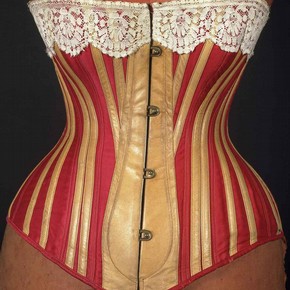
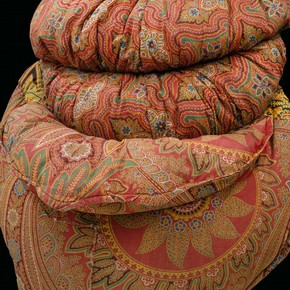
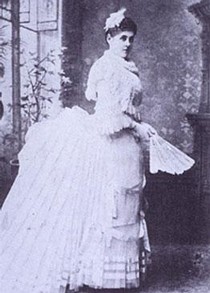
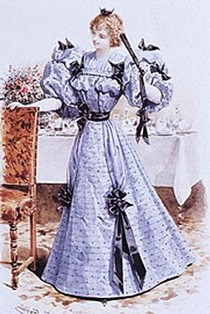
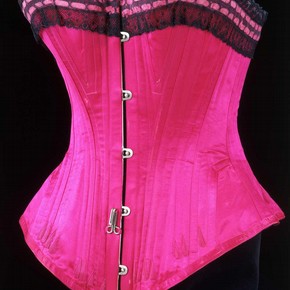
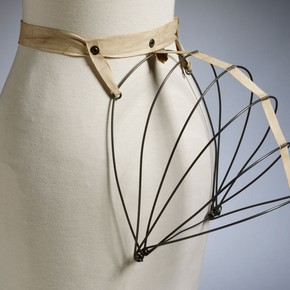
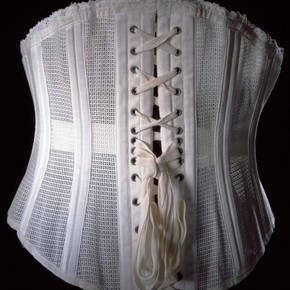
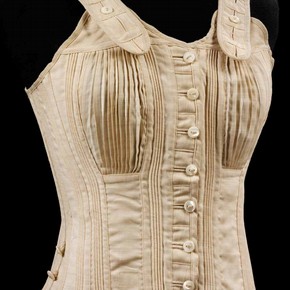
No comments:
Post a Comment